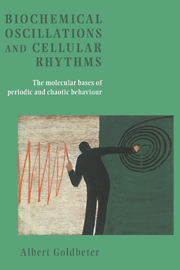Book contents
- Frontmatter
- Contents
- Foreword to the English edition by Michael Berridge
- Foreword to the French edition by Ilya Prigogin
- Preface
- 1 Introduction
- Part I Glycolytic oscillations
- Part II From simple to complex oscillatory behaviour
- Part III Oscillations of cAMP in Dictyostelium cells
- Part IV From cAMP signalling in Dictyostelium to pulsatile hormone secretion
- 8 Function of the rhythm of intercellular communication in Dictyostelium: link with pulsatile hormone secretion
- Part V Calcium oscillations
- Part VI The mitotic oscillator
- Part VII Circadian rhythms
- References
- Index
8 - Function of the rhythm of intercellular communication in Dictyostelium: link with pulsatile hormone secretion
Published online by Cambridge University Press: 26 February 2010
- Frontmatter
- Contents
- Foreword to the English edition by Michael Berridge
- Foreword to the French edition by Ilya Prigogin
- Preface
- 1 Introduction
- Part I Glycolytic oscillations
- Part II From simple to complex oscillatory behaviour
- Part III Oscillations of cAMP in Dictyostelium cells
- Part IV From cAMP signalling in Dictyostelium to pulsatile hormone secretion
- 8 Function of the rhythm of intercellular communication in Dictyostelium: link with pulsatile hormone secretion
- Part V Calcium oscillations
- Part VI The mitotic oscillator
- Part VII Circadian rhythms
- References
- Index
Summary
Whereas the function of glycolytic oscillations, at least in yeast, remains puzzling, the same does not hold for the role of cAMP oscillations in Dictyostelium amoebae. After reviewing the different aspects of the function of these oscillations and the molecular bases for the efficiency of pulsatile signalling, a link is established here with the rhythmic, pulsatile secretion observed for an increasing number of hormones. Besides their circadian modulation (Van Cauter & Aschoff, 1989), many hormones are indeed secreted in the form of ultradian, highfrequency pulses (Crowley & Hofler, 1987; Negro-Vilar et al., 1987). Particular attention is devoted below to the pulsatile release of gonadotropic hormones by the pituitary in response to pulses of the gonadotropin-releasing hormone (GnRH), emitted by the hypothalamus with a frequency close to one pulse per hour.
A model for the response of target cells to pulsatile stimulation in the presence of receptor desensitization allows us to investigate, in a general manner, the encoding of the pulsatile signal in terms of its frequency. This analysis, applied to the cAMP signalling system and to the pusatile release of GnRH, suggests the existence, in both cases, of a frequency capable of inducing an optimum response. The model shows how this optimum frequency is related to the kinetics of reversible desensitization in target cells. The validity of the results obtained in the general model is corroborated by the fact that similar results are recovered in the specific model for cAMP signalling based on receptor desensitization.
Beyond the case of GnRH, the conclusions on the existence of an optimum frequency of pulsatile signalling probably extend to other hormones, as is discussed for the cases of insulin and growth hormone.
- Type
- Chapter
- Information
- Biochemical Oscillations and Cellular RhythmsThe Molecular Bases of Periodic and Chaotic Behaviour, pp. 303 - 348Publisher: Cambridge University PressPrint publication year: 1996



